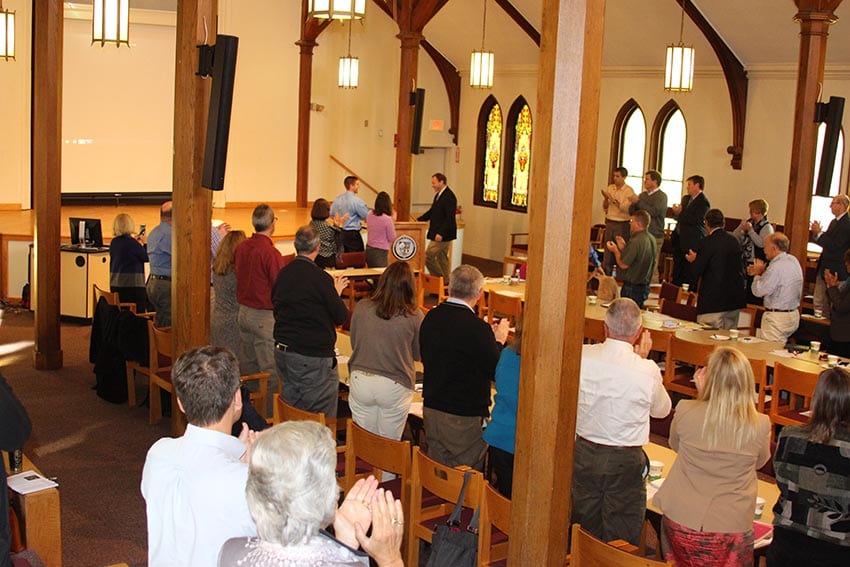February 26, 2016
Bangor Daily News
By Meg Haskell, BDN Staff
By the time Cecile Lyle, a 75-year-old widow in Sanford, pays the $800 rent and utility bills each month for the one-bedroom apartment she shares with her physically disabled daughter, Madeleine, there’s not much money left for groceries, clothing, transportation and other necessities.
“It leaves us with almost nothing left over,” Lyle said in a recent phone interview. “We can’t even afford a little luxury like going out for breakfast once a month. Sometimes I have to ask my sister for some money just to make ends meet.”
Lyle, whose only income is her monthly social security check, put her name on a waiting list in 2012 for a less costly apartment in a low-income, seniors-only complex where she would pay closer to $500, but there’s no indication a place will become available any time soon.
“It would be a heck of a lot better,” she said. “It would give me the chance to see the light a little more clearly.”
“There is almost no senior housing in Sanford,” Lyle said. “And I’m not alone. There are hundreds of others like us around here who have no place to turn.”
In fact, there are at least 9,000 households such as Lyle’s on waiting lists in Maine, headed by low-income adults and couples age 55 and older, living in houses and apartments they can’t afford because less expensive, safer, more energy-efficient options don’t exist. That figure comes from a 2015 survey conducted by Abt Associates, a Massachusetts-based policy research organization, in support of a $15 million general obligation bond issue to build about 250 units of energy-efficient housing for low-income seniors across the state. The bond issue would leverage an additional $22.6 million in federal low-income tax credits and other funding for the projects.
Nearly 70 percent of voters approved the bonding question in November 2015, and the measure has the strong support of senior advocacy groups, service organizations and construction groups. But Gov. Paul LePage has not yet approved the sale of the bonds; neither has he responded publicly to a letter sent Feb. 16 from Maine Housing Authority Chairman Peter Anastos, whose organization would administer the funding, seeking clarification on the governor’s position.
Once approved by voters, the governor has five years to issue bonds before they expire. LePage has been defying voters on voter-approved bonds throughout his time as governor. Late last year, he announced he would approve the sale in more than $11 million in conservation bonds for the Land for Maine’s Future program after months about being criticized about blocking them from across Maine.
Given LePage’s stated opposition to the senior housing bond issue and his history of withholding voter-approved bonds, Anastos’ letter takes a cautious tone in asking the governor’s intentions.
“Before we encourage developers to invest their time and money and before we obligate staff resources to this project, it would be helpful to know if and when you plan to approve the bonds,” the letter reads.
Earlier this week, LePage spokeswoman Adrienne Bennett said LePage plans to meet with Anastos and MaineHousing Director John Gallagher in the coming week. She declined to comment on the governor’s thinking about the bond issue.
‘Desperate situations’
Meanwhile, the problem is not going away. Maine has the highest percentage in the nation of residents age 65 and older, with 50 more people turning 65 every day. By 2030, one in four Mainers will be 65 or older. Maine has the eighth-oldest housing stock of all the states, with 31 percent of homes and apartment complexes built before 1950. About a third of older Mainers live on Social Security alone, with an average annual benefit of about $13,000, according to the Maine Council on Aging, and at least a quarter also claim at least one disability.
Senior advocates say it’s a slow-motion housing disaster in the making. The 9,000-unit gap between current demand and availability is projected to rise to a 15,000-unit gap by 2020 if additional affordable housing is not developed, and it can only get worse as the baby boom generation continues to age.
Eligibility for federally designated affordable housing is limited in most cases to households that earn 80 percent or less of the Area Median Income, and rents typically are capped between 30 and 40 percent of that monthly figure.
“There is a significant and rapidly growing demand for this housing,” said Jess Maurer, executive director of the Maine Association of Area Agencies on Aging and co-chair of the Maine Council on Aging. The problem is especially pronounced in Maine’s more rural areas, she said, where many seniors own their homes but lack the physical or financial ability to maintain them safely.
“Our area agencies get calls from people whose roofs have collapsed, whose foundations have fallen in, whose furnaces have stopped working,” she said. “Or maybe they’ve had a hip fracture and now they can’t climb the stairs to get to the only bathroom.”
Neglected maintenance means many older homes are drafty and expensive to heat, and many are dangerous as well. The scenarios are endless, Maurer said, and while some Mainers hold on stubbornly to their homes and their independence despite substandard conditions and insupportable expenses, others are more than ready to transition to safer, more convenient, more affordable apartment living — if only it were available.
At the Penquis Agency in Bangor, Housing Development Director Jason Bird oversees the management of 286 units of affordable housing for all ages. He said there are 370 people 55 and older waiting for one of the agency’s 115 seniors-only apartment units. There are no openings.
“We could have twice as many units and still not meet the demand,” Bird said. “People can be on a wait list for years and still not get in.”
“There is an intense and growing unmet need for affordable housing,” said Greg Payne, director of the Maine Affordable Housing Coalition and a development officer at Avesta Housing, a Portland-based nonprofit that develops affordable housing in southern Maine and New Hampshire.
In 2015, more than 3,300 people approached Avesta for affordable housing, according to a company report, an increase of 9 percent over the year before. The largest increase, 36 percent, came from senior households. The average annual income of all applicants was $14,400.
Older Mainers are enduring “desperate situations,” Payne said, and property developers and construction groups across the state are eager to get started.
Builders want to break ground this spring, he said, but developers won’t move forward with land purchases, state and municipal permitting and architectural design work without knowing the voter-approved bonds have been issued.
Demand in urban and rural areas
Affordable senior housing complexes exist throughout the state, in urban and rural areas. The language of the bond measure stipulates that at least four of the new projects be built in counties with populations of 100,000 or fewer, which includes 11 of Maine’s 16 counties. Preference for all projects will be given to locations that can provide transportation, health care and other essential services.
One of those projects may well be in Machias, where the Washington Hancock Community Agency owns a buildable parcel near the downtown, in easy walking distance to the grocery store and other amenities.
Washington County Manager Betsy Fitzgerald confirmed the need is growing, but she cautioned that area residents are often too proud to leave their longtime homes, even when the conditions are dire.
“If you tell them, ‘I’m going to build you some elderly housing,’ they’re going to say, ‘Thank you very much, but we’re getting by alright,’” she said.
Many are reluctant to put their homes on the market, and others realize their properties may not be in saleable condition. Still, she predicted, if attractive, affordable housing becomes available in Machias, “before long there will be a line and a waiting list.”
Developer Brian Bowman of Bowman Constructors in Pittsfield is cautiously interested in the Machias site, perhaps as part of a “scattered site” development that uses a single design approach for a group of projects in different locations. For example, a plan for a small-scale development in Machias could be adapted for a similar project in Jonesport or another community in the downeast region, cutting down on development costs.
“It’s a long process,” he said of the planning and permitting phase, and it’s one that can’t even begin to take shape until the bonds are released and the Maine Housing Authority issues a request for proposals.
There’s a lot of speculation at high levels about the future of the housing bonds and the projects they are intended to support, and many eyes will be on the anticipated meeting next week between the governor and the housing authority leaders.
On Thursday, the Maine Council on Aging issued a statement urging LePage to release the senior housing bonds.
“The shortage of affordable senior housing in Maine is a growing and significant crisis. Older adults can no longer live in their homes but cannot find the safe, affordable housing they need,” co-chair Jess Maurer said. “This bond was passed by a broad bipartisan majority of lawmakers and approved by nearly 70 percent of Maine voters. We need the governor to release these funds now to stem the growing demand for this housing.”
In Sanford, Cecile Lyle is optimistic the process will move forward if enough voices join in.
“I hope they can make the governor open his eyes, and his heart,” she said. “I am not alone. There is a lot of need out here.”


